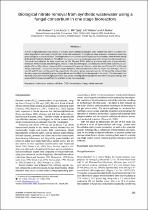 ResearchSpace
ResearchSpace
Biological nitrate removal from synthetic wastewater using a fungal consortium in one stage bioreactors
JavaScript is disabled for your browser. Some features of this site may not work without it.
- ResearchSpace
- →
- Research Publications/Outputs
- →
- Journal Articles
- →
- View Item
| dc.contributor.author |
Greben, HA

|
|
| dc.contributor.author |
Joubert, LM

|
|
| dc.contributor.author |
Tjatji, MP

|
|
| dc.contributor.author |
Whites, HE

|
|
| dc.contributor.author |
Botha, A

|
|
| dc.date.accessioned | 2008-08-14T12:36:51Z | |
| dc.date.available | 2008-08-14T12:36:51Z | |
| dc.date.issued | 2007-04 | |
| dc.identifier.citation | Greben, HA et al. 2007. Biological nitrate removal from synthetic wastewater using a fungal consortium in one stage bioreactors. Water SA, Vol. 33(2), pp 285-290 | en |
| dc.identifier.issn | 1816-7950 | |
| dc.identifier.uri | http://www.wrc.org.za | |
| dc.identifier.uri | http://hdl.handle.net/10204/2383 | |
| dc.description | Copyright: 2007 Water Research Commission | en |
| dc.description.abstract | A series of lignocellulosic fungi, capable of cellulase and/or xylanase production, were isolated from soil to be used for cellulose degradation and nitrate removal from nitrate-rich wastewater in simple one-stage anaerobic bioreactors containing grass cuttings as source of cellulose. The fungal consortium, consisting of six hyphomycetous isolates, some of which belong to the genera Fusarium, Mucor and Penicillium, was able to remove a significant portion of the nitrate from the treated water. The results were obtained for three bioreactors, i.e. FR, FRp and AFRp, differing in volume and mode of grass addition. Bioreactor AFRp received autoclaved grass, instead of non-autoclaved grass containing natural microbial consortia, as supplied to FR and FRp. Nitrate removal in FR amounted to 89% removal efficiency, while this was 65% and 67% in FRp and AFRp, respectively. The residual chemical oxygen demand (COD) concentration in FR was higher than 600 mg/ℓ, while it was 355 and 379 mg/ℓ in FRp and AFRp, respectively. The similar nitrate removal results for AFRp and FRp indicated that the micro-organisms attached to grass cuttings did not seem to affect the nitrate removal in the reactor. This observation has led to the conclusion that the fungal consortium was, except for being able to degrade cellulose within the grass cuttings, also responsible for nitrate removal from the synthetic nitrate-rich wastewater | en |
| dc.language.iso | en | en |
| dc.publisher | Water Research Commission | en |
| dc.subject | Bioreactors | en |
| dc.subject | Acetate | en |
| dc.subject | Cellulose | en |
| dc.subject | COD | en |
| dc.subject | Fermentation | en |
| dc.subject | Fungi | en |
| dc.subject | Nitrate removal | en |
| dc.title | Biological nitrate removal from synthetic wastewater using a fungal consortium in one stage bioreactors | en |
| dc.type | Article | en |
| dc.identifier.apacitation | Greben, H., Joubert, L., Tjatji, M., Whites, H., & Botha, A. (2007). Biological nitrate removal from synthetic wastewater using a fungal consortium in one stage bioreactors. http://hdl.handle.net/10204/2383 | en_ZA |
| dc.identifier.chicagocitation | Greben, HA, LM Joubert, MP Tjatji, HE Whites, and A Botha "Biological nitrate removal from synthetic wastewater using a fungal consortium in one stage bioreactors." (2007) http://hdl.handle.net/10204/2383 | en_ZA |
| dc.identifier.vancouvercitation | Greben H, Joubert L, Tjatji M, Whites H, Botha A. Biological nitrate removal from synthetic wastewater using a fungal consortium in one stage bioreactors. 2007; http://hdl.handle.net/10204/2383. | en_ZA |
| dc.identifier.ris | TY - Article AU - Greben, HA AU - Joubert, LM AU - Tjatji, MP AU - Whites, HE AU - Botha, A AB - A series of lignocellulosic fungi, capable of cellulase and/or xylanase production, were isolated from soil to be used for cellulose degradation and nitrate removal from nitrate-rich wastewater in simple one-stage anaerobic bioreactors containing grass cuttings as source of cellulose. The fungal consortium, consisting of six hyphomycetous isolates, some of which belong to the genera Fusarium, Mucor and Penicillium, was able to remove a significant portion of the nitrate from the treated water. The results were obtained for three bioreactors, i.e. FR, FRp and AFRp, differing in volume and mode of grass addition. Bioreactor AFRp received autoclaved grass, instead of non-autoclaved grass containing natural microbial consortia, as supplied to FR and FRp. Nitrate removal in FR amounted to 89% removal efficiency, while this was 65% and 67% in FRp and AFRp, respectively. The residual chemical oxygen demand (COD) concentration in FR was higher than 600 mg/ℓ, while it was 355 and 379 mg/ℓ in FRp and AFRp, respectively. The similar nitrate removal results for AFRp and FRp indicated that the micro-organisms attached to grass cuttings did not seem to affect the nitrate removal in the reactor. This observation has led to the conclusion that the fungal consortium was, except for being able to degrade cellulose within the grass cuttings, also responsible for nitrate removal from the synthetic nitrate-rich wastewater DA - 2007-04 DB - ResearchSpace DP - CSIR KW - Bioreactors KW - Acetate KW - Cellulose KW - COD KW - Fermentation KW - Fungi KW - Nitrate removal LK - https://researchspace.csir.co.za PY - 2007 SM - 1816-7950 T1 - Biological nitrate removal from synthetic wastewater using a fungal consortium in one stage bioreactors TI - Biological nitrate removal from synthetic wastewater using a fungal consortium in one stage bioreactors UR - http://hdl.handle.net/10204/2383 ER - | en_ZA |





